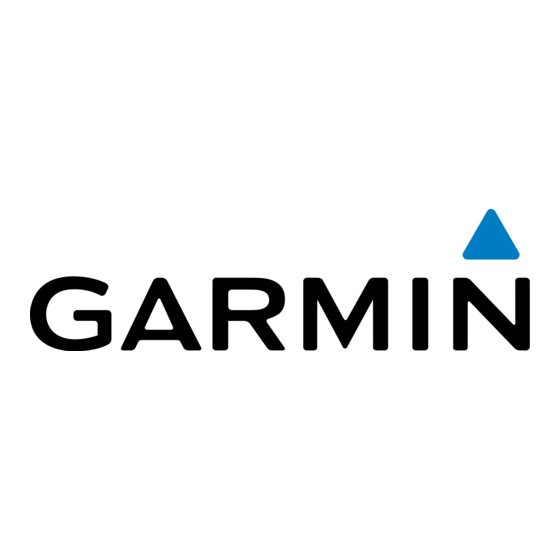Garmin GHP 10 Marine Autopilot System Kurulum Talimatları Kılavuzu - Sayfa 11
Deniz GPS Sistemi Garmin GHP 10 Marine Autopilot System için çevrimiçi göz atın veya pdf Kurulum Talimatları Kılavuzu indirin. Garmin GHP 10 Marine Autopilot System 26 sayfaları. Tachometer reference
Ayrıca Garmin GHP 10 Marine Autopilot System için: Hızlı Başlangıç Kılavuzu (21 sayfalar), Kurulum Talimatları Kılavuzu (48 sayfalar), Teknik Referans (42 sayfalar), Uygunluk Beyanı (1 sayfalar), Referans (1 sayfalar)

Securing the CCu in the CCu Bracket
1. Connect the CCU/ECU
interconnect cable and the NMEA
2000 drop cable to the CCU.
2. Place the CCU in the mounting
portion of the CCU bracket with
the wires hanging straight down
➊.
3. Place the securing portion of the
bracket over the ball and snap
it into the mounting portion of
the bracket, starting with the
two arms ➋ that do not have the
thumbscrew ➌.
4. With the cables hanging straight
down, connect the arm with the thumbscrew.
The cables must hang straight down for the CCU to accurately read
your heading.
5. Hand-tighten the thumbscrew until the CCU is held firmly in the
bracket.
Do not overtighten the thumbscrew.
Connecting the CCu
1. Route the six-pin connector end of the CCU/ECU interconnect cable
to the ECU and make the connection.
2. Route the wires from the bare-wire portion of the cable to the CCU/
ECU interconnect cable.
• Route the red and blue wires to the location where you plan to
install the alarm
(page
If the cable is not long enough, extend the appropriate wires with
28 AWG (.08 mm
) wire.
2
• Route the yellow wire to the location where you plan to install
the GHC 10
(page
11).
If the cable is not long enough, extend the yellow wire with 22
AWG (.33 mm
) wire.
2
3. Cut and tape the remaining bare wires; they are not used.
Connecting the GHP to the tachometer
1. If you are connecting analog tachometry, identify the location and
connection assignments for the tachometer (or tachometers) on your
boat.
2. Route the bare-wire end of the CCU/ECU interconnect cable to the
tachometer (or tachometers).
If the cable is not long enough, extend the wires with twisted pair,
22 AWG wire.
3. Connect the cables, based on the table below.
Engine
tachometer
Configuration
Single engine
Green and violet (twist
together)
Dual engines
Port engine = violet
Starboard engine = green
4. Connect the tachometer wire or wires from the CCU/ECU
interconnect cable to the tachometer sensor wire or wires from the
engine (or engines). Connect the ground wires to a clean ground.
NOTE: For three or more outboard engines, connect to the
outermost port and starboard engines, according to the table.
5. Solder and cover all bare-wire connections.
GHP 10 Installation Instructions
➌
➊
11).
Ground
White and grey (twist
together)
Port engine = grey
Starboard engine =
white
alarm Installation
The alarm audibly alerts you to important GHP 10 events.
To install the alarm, you must mount it to your boat
it to the CCU
(page
on the GHC 10
(page
Mounting the alarm
Before you can mount the alarm, you must select a mounting location
(page
5).
Secure the alarm with cable ties or other appropriate mounting
➋
hardware (not included).
Connecting the alarm
1. Route the alarm-cable to the bare-wire end of the CCU/ECU
interconnect cable.
If the cable is not long enough, extend the appropriate wires with 28
AWG (.08 mm
2. Connect the cables, based on the table below.
alarm Wire Color CCu/ECu Interconnect Cable Wire Color
White (+)
Black (-)
3. Solder and cover all bare-wire connections.
GHC 10 Installation
Install the GHC 10 by flush-mounting it in the dashboard near the helm,
connecting it to the yellow wire from the CCU/ECU interconnect cable,
and connecting it to a NMEA 2000 network.
To use advanced features of the GHP 10, optional NMEA
2000-compatible or NMEA 0183-compatible devices, such as a GPS
device, can be connected to the NMEA 2000 network or connected to
the GHC 10 through NMEA 0183.
Mounting the GHC 10
The temperature range for the GHC 10 is from 5°F to 158°F (from
-15°C to 70°C). Extended exposure to temperatures outside of this
range (in storage or operating conditions) may cause failure of the
LCD screen or other components. This type of failure and related
consequences are not covered by the manufacturer's limited warranty.
If you are mounting the GHC 10 in fiberglass, when drilling the
four pilot holes, it is recommended to use a countersink bit to drill a
clearance counterbore through only the top gel-coat layer. This will
help to avoid any cracking in the gel-coat layer when the screws are
tightened.
Stainless-steel screws may bind when screwed into fiberglass and
overtightened. Garmin recommends applying an anti-galling, stainless
anti-seize lubricant to the screws before installing them.
Before you can mount the GHC 10, you must select a mounting location
(page
5).
1. Trim the flush-mount template and ensure it will fit in the location
where you plan to mount the GHC 10.
The flush-mount template is included in the product box, not in
these instructions.
The flush-mount template has adhesive on the back.
2. Remove the protective liner from the adhesive on the back of the
template and apply it to the location where you plan to mount the
GHC 10.
10), and connect it to the yellow CCU signal wire
11).
) wire.
2
Red (+)
Blue (-)
Notice
(page
10), connect
11
